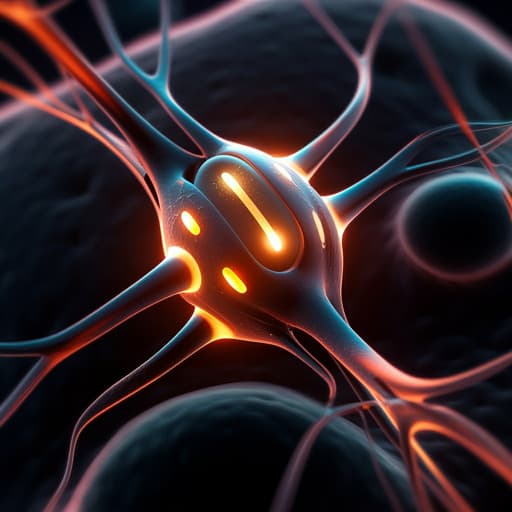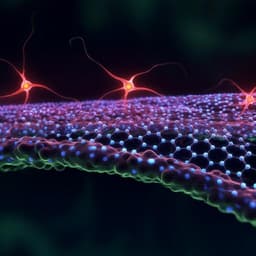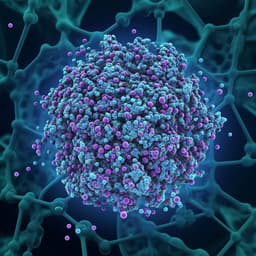
Biology
Recent developments in multifunctional neural probes for simultaneous neural recording and modulation
H. Li, J. Wang, et al.
Explore the groundbreaking advancements in multifunctional neural probes that allow for simultaneous neural activity recording and modulation through innovative chemical, electrical, and optical stimulation techniques. This exciting research was conducted by Hongbian Li, Jinfen Wang, and Ying Fang.
~3 min • Beginner • English
Introduction
The review addresses how to achieve simultaneous monitoring and modulation of neural activity at cellular resolution to probe causal relationships between neural circuits and behavior. It outlines the context that extracellular recording probes bridge ionic neural signals and electronic readouts, and that advances from rigid to soft probes have improved chronic stability. The purpose is to summarize recent developments in multifunctional probes that integrate recording with controlled modulation (chemical, electrical, optical), emphasizing materials and structural designs that improve tissue interfaces and enable long-term, high-resolution studies. The importance lies in enabling closed-loop neuroscience experiments and potential therapies by recording neural activity while delivering precise, localized perturbations to specific neuronal populations.
Literature Review
- Chemical delivery-integrated probes: Early approaches integrated microfluidic channels with electrodes to locally infuse neuromodulators while recording, including PDMS microfluidics with staggered herringbone mixers on silicon probes for rapid drug mixing and delivery (Shin et al.). Flexible polymer-based probes (PI, SU-8, PDMS) reduce chronic inflammation versus rigid silicon; SU-8 probes with closely spaced fluidic outlets and electrodes enabled simultaneous delivery and recording in hippocampus. Wireless, battery-powered infrared actuation of PDMS microfluidics with Joule-heated expandable reservoirs enabled programmable drug delivery in freely moving mice with 10×10 µm2 channels (Jeong et al.). Refillable plug-n-play cartridge systems allowed >4 weeks delivery (Qazi et al.). Sustained release via surface-loaded nanogels improved mechanical compliance and allowed stable recordings >4 weeks (Huang et al.). Conducting polymers (PPy, PEDOT) co-deposited with drugs enabled electrically triggered release but with limited spatiotemporal control. Organic electronic ion pumps using PEDOT:PSS membranes electrophoretically transported ions (e.g., K+) to modulate activity; a 32-channel bioelectronic pixel array paired 20×20 µm electrodes with 20 µm outlets, demonstrating single-cell-scale chemical modulation and recording in vitro, though device thickness and shared reservoirs limited in vivo use and independent site control (Jonsson et al.).
- Electrical stimulation-integrated probes: Stimulation efficacy depends on charge injection capacity (CIC). CIC improved by increasing effective surface area via porous/rough coatings (Pt, Au, IrO2, TiN, CNTs, graphene; conducting polymers PPy, PEDOT) and via structural engineering (CNT arrays, carbon nanofibers, porous Pt nanorods). Fiber electrodes (graphene fibers, CNT fibers/yarns) offer high surface area from nanowrinkles, small cross-sections that minimize insertion damage, and compatibility with deep stimulation/fMRI. Ultrathin multifunctional probes with integrated recording/stimulation on resorbable silk carriers formed conformal, biocompatible interfaces enabling high spatiotemporal modulation/recording; additional concepts include bioresorbable, self-healing, and morphing electronics for transient or adaptive interfaces. Challenges include stimulation artifacts orders of magnitude larger than spikes, lack of cell-type specificity, and potential irreversible electrode reactions reducing efficiency with repeated use.
- Optical modulation with simultaneous recording: Optogenetics enables millisecond, cell-type-specific modulation. For surface ECoG, transparent electrodes are required: brittle ITO arrays on parylene-C with integrated microLEDs recorded light-evoked signals; graphene-based CLEAR arrays provided ~90% transmittance and artifact-free recording; contamination-free single-layer graphene minimized light-induced artifacts; to overcome graphene’s conductivity limits at small scales, transparent metal meshes/grids (Au mesh via polystyrene sphere templating; Au nanowire networks) delivered high transparency (up to 87%) and low impedance (e.g., 18.6 Ω at 1 kHz) enabling artifact-free 2D mapping; CNT spider-web networks in PDMS produced transparent, stretchable ECoG arrays with minimal impedance change at 20% strain and robustness under impact.
- Depth optrodes and microLEDs: Traditional silica optical fibers with tetrode bundles (“optetrodes”) enabled recordings in freely moving mice but remain bulky and rigid. Micro-optoelectrode arrays using transparent ZnO micropillars served as both waveguides and electrodes, detecting spikes at light powers ~1.79 µW from micrometer apertures; PEG-mediated assembly with viral vectors allowed one-step AAV delivery, implantation, and long-term combined recording/modulation. Soft alginate–polyacrylamide hydrogel optical fibers matched brain-like moduli (tens of kPa) and reduced inflammatory responses versus silica, albeit with higher propagation loss limiting deep stimulation. MicroLEDs (µ-ILEDs) enable compact, tetherless light delivery; wireless, flexible multilayer probes integrating 50×50 µm GaN µ-ILEDs with Pt electrodes, photodetectors, and temperature sensors achieved cellular-scale targeting and reduced neuronal loss compared to metal cannulas and fibers.
- Upconverting nanoparticles (UCNPs): To leverage deeper tissue penetration of NIR light, lanthanide-doped UCNPs convert NIR to visible emission for opsin activation. Demonstrations include NaYF4:Sc/Yb/Er and NaYF4:Sc/Yb/Tm@NaYF4 nanorods emitting green/blue to stimulate opsin-expressing cells; intra-VTA injections enabled NIR-evoked dopamine release in behaving rodents. Emission efficiency improvements addressed surface quenching: core–shell NaYF4:Tm/Er@NaYF4 increased brightness for in vivo modulation; dye-sensitized core–active shell designs (IR-806 sensitizer) yielded ~1000× luminescence enhancement enabling robust ReaChR activation; core–shell–shell architectures confined Yb3+ to reduce concentration quenching and boosted 540–570 nm emission ~3×, enabling reliable wireless inhibition of eNpHR-expressing neurons.
- Fiber-based multifunctional probes: Thermally drawn all-polymer fibers integrated PC waveguides, cyclic olefin copolymer cladding, conductive polyethylene electrodes, and microfluidic channels for simultaneous optical stimulation, drug delivery, and recording, with small cross-sections minimizing inflammation and enabling chronic use (>2 months) in freely moving mice. Adding graphite reduced electrode resistance, enabling 20–25 µm electrode diameters and single-step virus injection plus optrode implantation via integrated microchannels. Spatially expandable probes used helical scaffolds to deploy multiple multifunctional fibers from a single insertion to reach distant targets for simultaneous multi-region recording and optical/chemical modulation. Hydrogel-matrix-held fiber probes exhibited extremely low bending stiffness (~0.42 N m−1), minimal foreign body responses, and enabled stable single-unit tracking over >6 months in freely moving mice.
Methodology
This is a narrative review synthesizing recent advances in multifunctional neural probes that enable simultaneous neural recording and modulation across chemical, electrical, and optical modalities. The authors emphasize material choices (e.g., metals, metal oxides, conducting polymers, carbons, hydrogels), structural designs (e.g., porous/rough coatings, nanostructured electrodes, meshes/grids, fiber drawing, microfluidics, microLED integration), and probe–tissue interface engineering (rigid versus soft, miniaturization, flexibility, stretchability). Representative studies are summarized with device architectures, key performance metrics (e.g., electrode dimensions, transparency, impedance, mechanical modulus, implantation footprint, chronic stability), and demonstrated in vitro/in vivo applications. It is not a systematic review or meta-analysis; rather, it organizes the literature by modulation modality (chemical, electrical, optical), device form factor (ECoG versus depth), and enabling technologies (e.g., UCNPs, thermally drawn fibers), highlighting illustrative examples and reported outcomes.
Key Findings
- Chemical delivery-integrated probes: Microfluidic–electrode hybrids enable localized neuromodulator infusion with concurrent recording; wireless PDMS microfluidics with 10×10 µm2 channels permit programmable pharmacology in freely moving mice; refillable cartridges enable >4-week delivery. Drug-loaded nanogels on probes improve compliance and stable recording >4 weeks. Conducting polymer (PPy, PEDOT) drug co-deposition allows electrically triggered release but with limited spatiotemporal precision. Organic ion pumps pair 20×20 µm electrodes with 20 µm outlets for single-cell-scale chemical modulation/recording in vitro, though shared reservoirs limit per-site control.
- Electrical stimulation interfaces: CIC is significantly increased by high-surface-area coatings (Pt, Au, IrO2, TiN, CNTs, graphene; PPy, PEDOT) and by nanostructuring (CNT arrays, carbon nanofibers, porous Pt nanorods). Fiber electrodes (graphene/CNT fibers) provide small cross-sections reducing implant damage and support deep stimulation and concurrent fMRI. Ultrathin, silk-supported probes achieve conformal interfaces for high-resolution modulation/recording; emerging transient, self-healing, and morphing electronics add functionality. Persistent challenges include large stimulation artifacts, lack of cell-type specificity, and electrode degradation with repeated pulses.
- Transparent ECoG for optogenetics: ITO arrays on parylene-C with integrated LEDs record visually evoked activity; graphene CLEAR arrays provide ~90% transmittance and artifact suppression. Transparent metallic meshes/grids (Au) and Au nanowire networks deliver high transparency (up to 87%) with low impedance (as low as 18.6 Ω at 1 kHz), enabling artifact-free 2D mapping; CNT spider-web networks in PDMS maintain impedance within +26% at 20% tensile strain and remain functional under mechanical impact.
- Depth optrodes and microLEDs: Optetrodes record light-evoked spikes in freely moving mice but are relatively bulky. ZnO micropillar MOAs act as waveguides and electrodes, detecting spikes at light power ~1.79 µW through micrometer apertures. Hydrogel optical fibers (modulus tens of kPa) reduce inflammatory response compared with silica but suffer higher propagation loss limiting deep use. Wireless, flexible µ-ILED probes with 50×50 µm emitters target cellular-scale volumes and reduce neuronal loss versus metal cannulas and fibers.
- UCNP-mediated NIR optogenetics: UCNPs enable deep-tissue NIR activation without implanted light guides. Core–shell and dye-sensitized designs mitigate surface quenching, achieving up to ~1000× luminescence enhancement and ~3× increases in specific bands, enabling robust activation (e.g., ReaChR) and inhibition (e.g., eNpHR) in rodents; NIR-triggered dopamine release demonstrated in VTA.
- Thermally drawn and hybrid fiber probes: All-polymer multifunctional fibers integrate optics, electrodes, and microfluidics for chronic, minimally invasive, multimodal experiments (>2 months). Graphite-doped electrodes reduce size to 20–25 µm; microchannels enable single-step virus injection plus optrode implantation. Spatially expandable fiber arrays reach distant targets from a single insertion for multi-region modulation/recording. Hydrogel-matrix fiber hybrids achieve low bending stiffness (~0.42 N m−1) and stable single-unit recordings for >6 months.
Discussion
The reviewed technologies collectively advance the goal of simultaneous neural recording and modulation by co-localizing stimulation (chemical, electrical, optical) with high-fidelity recording at cellular-to-network scales. Material and structural innovations mitigate traditional trade-offs: soft polymers, hydrogels, and miniaturized fibers reduce inflammatory responses and insertion trauma, enabling stable long-term recordings; porous and nanostructured electrode surfaces elevate CIC for safer, efficient electrical stimulation; transparent and stretchable electrodes reconcile optical access with low impedance and mechanical compliance for ECoG optogenetics; integrated microLEDs offer compact, tetherless deep modulation; UCNPs leverage NIR tissue penetration to reduce invasiveness for deep targets; microfluidics and ion pumps provide localized, controllable chemical delivery with concurrent sensing. These capabilities address the need for closed-loop, cell-type-aware experiments, although key limitations persist: electrical stimulation artifacts challenge simultaneous spike recording; electrical methods lack inherent cell-type specificity; optical and chemical modalities face limits in spatial precision due to light scattering/propagation and diffusion. The synthesis highlights that combining modality-specific strengths (e.g., optogenetics for specificity with soft electrodes for chronic stability) and continued interface engineering are central to achieving high spatiotemporal control with minimal tissue disruption.
Conclusion
Multifunctional neural probes integrating recording with chemical, electrical, and optical modulation have transformed experimental access to neural circuits, enabling causal studies and potential therapeutic strategies. The review consolidates material and structural strategies—soft substrates, nanostructured and transparent electrodes, microfluidics, UCNPs, microLEDs, and thermally drawn/hydrogel fiber platforms—that improve stimulation efficiency, reduce tissue damage, and support chronic, multimodal operation across surface and depth targets. Future directions identified include: (i) developing mechanically compliant, miniaturized stimulation units (microfluidics, optics) with minimal footprints to reduce tissue responses for long-term use; (ii) achieving cell-type-specific modulation at single-neuron resolution with high spatiotemporal precision, potentially via new opsins, optical strategies, or hybrid electro-optical/chemo-genetic approaches; (iii) integrating environmental sensing (temperature, pH) and other modalities to monitor microenvironmental changes during modulation; and (iv) leveraging multidisciplinary collaborations across materials science, electronics, mechanics, and neuroscience to optimize probe designs and translational pathways.
Limitations
As a narrative review, the work synthesizes representative advances rather than conducting a systematic, quantitative comparison across all devices, leaving potential publication bias and incomplete coverage. Reported performance metrics derive from heterogeneous experimental conditions (in vitro versus in vivo, species, brain regions), limiting direct comparability. Many highlighted platforms demonstrate feasibility in acute or early chronic studies; long-term reliability, biostability, and safety (e.g., for UCNPs, conducting polymer coatings, microLED thermal effects) require further validation. Field-wide limitations noted by the authors include: rigid, large-footprint stimulation units that elevate tissue damage and inflammation; difficulty achieving type-specific, single-neuron modulation due to light scattering and chemical diffusion; stimulation-induced microenvironmental changes (temperature, pH) that are often unmonitored; and electrical stimulation artifacts and potential irreversible electrode reactions during repeated use.
Related Publications
Explore these studies to deepen your understanding of the subject.







